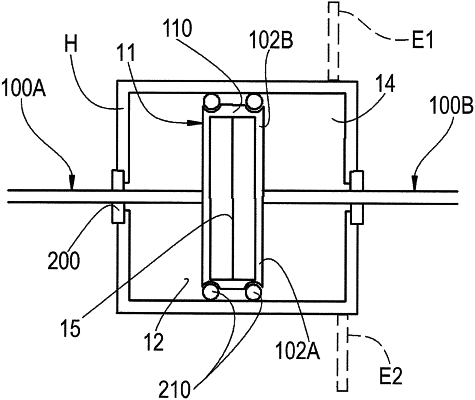| CPC F03G 7/005 (2013.01) [A61K 9/0004 (2013.01); F04B 19/006 (2013.01)] | 9 Claims |

|
1. A method of converting energy of an osmotic system into a different form of energy, the method comprising:
(a) providing a working body which defines an enclosure having a fluid filled cavity therein and having a semi-permeable membrane housed in the cavity which generally divides the cavity into first and second chambers, wherein the fluid filled cavity contains a solvent fluid having a solute contained therein, wherein the solvent fluid and the solute comprise an electrically conductive electrolyte solution;
(b) introducing an electric field to the working body and correspondingly driving an osmotic response across the semi-permeable membrane in a first direction of fluid transfer and converting forces associated with such fluid transfer into mechanical movement of an actuatable member in a corresponding first direction of movement, wherein the electric field changes a concentration of the solute within the solvent fluid within one of the first and second chambers, wherein the electric field is introduced by activating a first electrode and a second electrode, the first electrode and the second electrode being in electrical communication with the fluid filled cavity, and wherein when the first electrode and the second electrode are activated, cations and anions in the electrically conductive electrolyte solution are drawn to the first electrode and the second electrode, respectively;
(c) manipulating the electric field so as to drive an osmotic response across the semi-permeable membrane in a second, opposite, direction of fluid transfer and converting forces associated with such fluid transfer into mechanical movement of the actuatable member in a corresponding second, opposite, direction of movement, wherein the fluid transfer includes transferring the solvent fluid from the one of the first and second chambers with the relatively lesser concentration of solute, across the semi-permeable membrane, into the other one of the first and second chambers with the relatively greater concentration of solute,
wherein the osmotic response across the semi-permeable membrane in the first direction occurs after the first electrode and the second electrode have been activated for a sufficient amount of time, causing a concentration of the solute to be greater in the other one of the first and second chambers; wherein the solvent fluid flows from the one of the first and second chambers into the other one of the first and second chambers after the first electrode and the second electrode have been activated for the sufficient time, increasing a relative volume of the electrically conductive electrolyte solution in the other one of the first and second chambers and displacing the actuatable member; and wherein the osmotic response across the semi-permeable membrane in the second, opposite, direction occurs after the first electrode and the second electrode have been de-energized for a sufficient time and a concentration of the solute is greater in the one of the first and second chambers; and
(d) repeatedly manipulating the electric field such that the actuatable member cycles between first and second positions which respectively correspond to the first and second directions of movement.
|